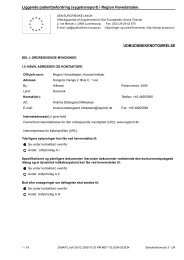Territorial Review Copenhagen - Region Hovedstaden
Territorial Review Copenhagen - Region Hovedstaden
Territorial Review Copenhagen - Region Hovedstaden
You also want an ePaper? Increase the reach of your titles
YUMPU automatically turns print PDFs into web optimized ePapers that Google loves.
258<br />
The industries in a given region must be checked for their sensitivity to<br />
transportation costs. For many sectors, the contribution of transport costs to<br />
overall value-added is not only very low but is also falling. Although several<br />
authors have proclaimed the death of distance, in many circumstances, faceto-face<br />
contact and the use of telecommunications may act as complements<br />
rather than as substitutes for each other. An increase in the quantity, variety<br />
and complexity of information produced itself increases the costs associated<br />
with transmitting this information across space. Much of the information<br />
will be of a non-standardised tacit nature, and the transmission of this type<br />
of information essentially requires face-to-face contact.<br />
Reductions in transport costs can have ambiguous effects on urban<br />
areas. High transport costs lead to decentralised production. The elimination<br />
of all transport costs may lead to production being moved from locations<br />
with high production costs and concentrated in locations with low<br />
production costs, i.e. peripheral locations. However, a partial reduction in<br />
transport costs may lead to increasing concentration in a core location, since<br />
the larger-scale economies outweigh lower transport costs.<br />
Firms‘ performances are affected by the level of housing and<br />
commuting costs, which can be called urban costs. High urban costs render<br />
firms less competitive on local and foreign markets. Increasing urban costs<br />
could shift employment from large monocentric cities either to their suburbs<br />
or to distant and smaller cities, where these costs are lower, at least once<br />
trade costs have sufficiently declined to permit large-scale exports to distant<br />
markets. Economic integration could thus well challenge the supremacy of<br />
large cities in favour of small cities (Cavailhès et al., 2007). The emergence<br />
of sub-centres within cities is a powerful strategy for large cities to maintain<br />
their attractiveness. The creation of sub-centres within a city, i.e. the<br />
formation of a polycentric city, appears to be a natural way to alleviate the<br />
burden of urban costs. However, for this to happen, firms set up in the<br />
secondary centres must maintain a very good access to the main urban<br />
centre, which requires low communication costs.<br />
Governance<br />
Institutional and governance arrangements create the conditions for<br />
economic activity to thrive. Close interaction among local political actors,<br />
the presence of a well-functioning civil society, regional administrations,<br />
and employers‘ organisations and trade unions favour economic<br />
development. Conversely, the absence of poles of collective action often<br />
leads to the formation of vicious circles of low growth. The lack or relative<br />
unimportance of collective organisations, and the presence of clientilistic<br />
practices facilitate migration and discourage economic activity. Different

















